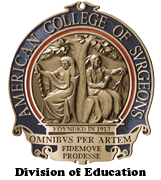Creation of Substitute Autologous Organs
Felicien M. Steichen

| Product Details | |
| Product ID: | ACS-1712 |
| Year Produced: | 1991 |
| Length: | 54 min. |
This video demonstrates: a) laryngopharyngoesoph-agectomy and reverse duodenal pyloric-greater curvature gastric tube with manual pharyngeal-duodenal anastomosis (Gavriliu II); b) total esophagectomy and reverse greater curvature gastric tube with manual cervical esophageal to gastric tube anastomosis (Gavriliu I); c) esophagoproximal gastrectomy and mechanical esophagogastrostomy to the distal gastric remnant (sequential anastomosis-resection) in the mid-chest; d) esophagoproximal gastrectomy, creation of short and narrow isoperistaltic greater curvature tube and circular esophagogastrostomy in the high or mid-chest with EEA instruments placed transabdominally and through the diaphragmatic hiatus; e) esophagectomy with resection of cardia and isoperistaltic, wide, greater curvature tube ("gastric tubulization") with manual or mechanical anastomosis to the esophagus above (neck) or below (chest) the clavicle; 1989; f) palliative, retrosternal isoperistaltic greater curvature tube in continuity at the prepyloric area with the lesser curvature gastric remnant; a manual or mechanical anastomosis of the tube to the cervical esophagus is performed, with the esophagus containing the tumor and the G-E junction left undisturbed (Postlethwait); g) also depicted is a total esophagectomy and esophagocoloplasty with esophagocolostomy (sequential anastomosis-resection) in the neck; h) esophagoproximal gastrectomy for stricture by gastroesophageal reflux also is depicted, as well as a transverse colon interposition with esophagocolostomy above the diaphragm (sequential anastomosis resection); i) an extended total gastrectomy with a Paulino jejunal pouch reconstruction is performed; the Roux-en-Y principle is used to create a 16-18 cm long jejunal pouch, some 42 cm distal to the esophagojejunostomy.



